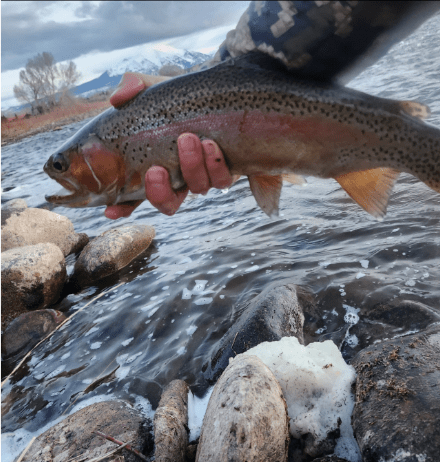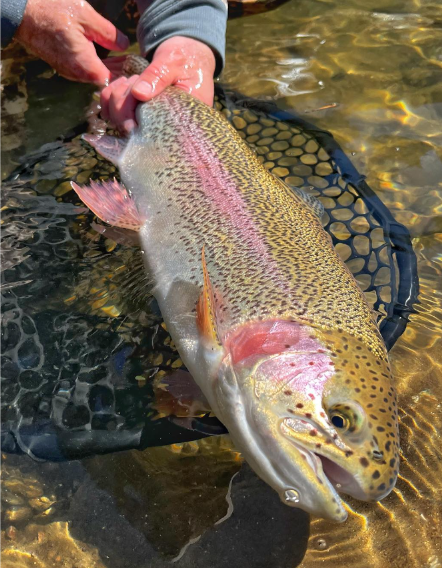Rainbow Trout Information
Colorado Rainbow Trout
Rainbow Trout (*Oncorhynchus mykiss*) are Colorado's most popular and sought-after trout species. Known for their vibrant colors and spirited fighting ability, Rainbow Trout provides an exciting and rewarding fly fishing experience.
Identification:
Rainbow Trout in Colorado possess notable physical traits that allow for easy identification. They have a sleek body shape and exhibit a coloration that transitions from silver to olive-green on their back, gradually lightening on their sides and belly. The distinguishing characteristic of Rainbow Trout is the prominent pink or red stripe that extends along their lateral line, giving rise to their name. Scattered dark spots across their body often accompany this distinctive stripe.

Habitat:
Rainbow Trout can be found in a number of habitats throughout Colorado. They thrive in transparent, cold water environments such as rivers, streams, and lakes, preferring areas with ample cover like submerged logs, boulders, and undercut banks. Rainbow Trout are known to inhabit both fast-flowing waters and slower, deeper pools, making them versatile and adaptable to different fishing conditions.
Behavior:
Rainbow Trout are known for their aggressive nature and voracious feeding habits. They are opportunistic feeders, targeting various food sources, including aquatic insects, small fish, and even terrestrial insects that fall into the water. Rainbow Trout are often found near the surface, making them prime targets for dry fly fishing techniques. They can also be caught using nymphs, streamers, and other traditional fly patterns.
Spawning
Rainbow Trout typically spawn in Colorado during spring, primarily from March to May. The specific timing can vary depending on water temperature and environmental conditions. During this period, Rainbow Trout migrate to suitable spawning grounds, usually in tributaries or shallower areas of rivers and streams. It's important to note that fishing regulations often have specific guidelines and restrictions during the spawning season to protect the trout population. It's recommended to consult local fishing regulations and procedures to ensure responsible angling practices and to avoid disturbing spawning Rainbow Trout in Colorado.
Seasonality:
Rainbow Trout can be targeted year-round in Colorado, but their behavior and feeding patterns can vary depending on the season. During the spring and fall, when water temperatures are more relaxed, Rainbow Trout tend to be more active and readily feed on various insects. In the warmer summer, they may seek deeper, calmer waters during the day's heat, becoming more active during early mornings and late evenings.

Fishing Tips
To increase the success rate when targeting Rainbow Trout in Colorado, consider the following tips:
- Fly Selection:Rainbow Trout are known to be opportunistic feeders, so it's essential to have a variety of fly patterns in your arsenal. Match the hatch by using flies that mimic the prevalent insects in your fishing area. Common fly patterns for Rainbow Trout include dry flies such as Elk Hair Caddis, Adams, Stimulators, and nymphs like Pheasant Tail, Hare's Ear, and Prince.
- Presentation:Pay attention to your fly presentation. Cast your fly upstream or across the current, allowing it to drift naturally with the flow. Watch for rising fish or subtle surface disturbances, indicating active feeding behavior.
- Stealth and Observation:Approach the fishing area cautiously, as Rainbow Trout can be easily spooked. Wear neutral-colored clothing, move slowly, and avoid making excessive noise. Take time to observe the water for any signs of feeding activity or the presence of insects.
- Timing:Consider fishing during low-light conditions, such as early mornings or evenings when Rainbow Trout feed more actively. These times of the day offer better chances of enticing a strike.
- Proper Catch-and-Release:If you keep a Rainbow Trout, ensure it complies with local regulations. However, catch-and-release practices are highly encouraged to preserve the trout population. Handle the fish gently, wet your hands before touching them, and release them quickly and carefully back into the water.
By understanding the characteristics, habitat preferences, and behavior of Rainbow Trout in Colorado, you can improve your fly fishing skills and increase your chances of a successful angling experience. Enjoy the beauty of Colorado's waters while pursuing these magnificent fish and creating lasting memories.
